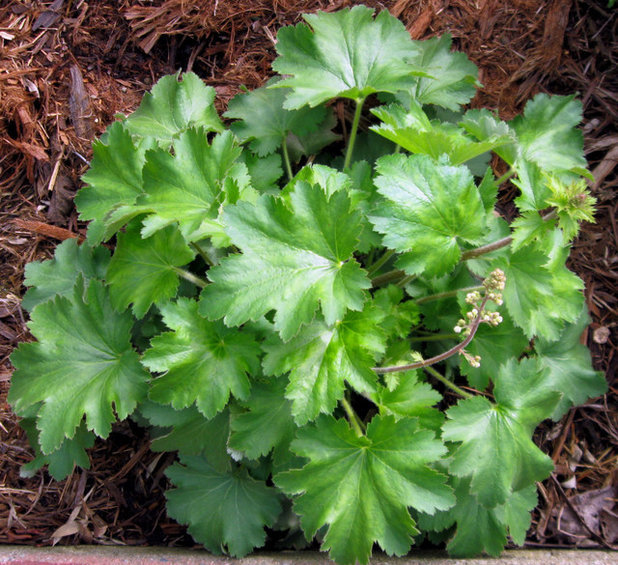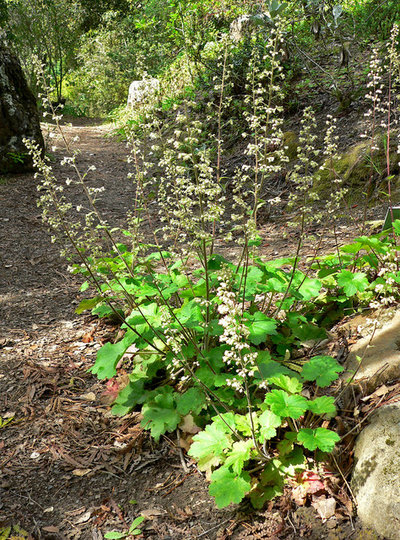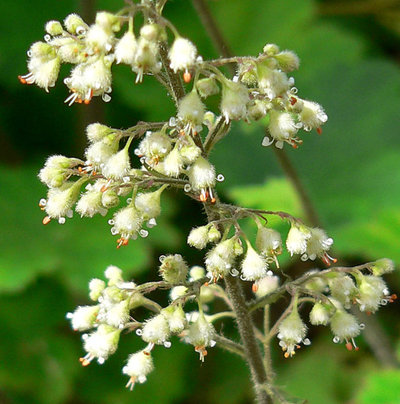Island alumroot
(Heuchera maxima), a native of California's Channel Islands and a shade-loving member of the Heuchera genus, is an attractive yet hardy underplanting companion for California’s native oaks and other large canopy trees.
Majestic oaks are icons of the native California landscape, but I often wonder how to use them in the garden. Lawns and other highly watered ground covers near the tree's base are off limits, and while oak leaves and acorns blanket the ground in a naturally beautiful way, the designed landscape sometimes calls for more.
Island alumroot's lush yet understated, large-lobed foliage covers the ground year-round, welcoming an explosion of petite bell-shaped flowers in late winter and early spring as a harbinger of spring's rewards.
 Botanical name: Heuchera maximaCommon names:
Botanical name: Heuchera maximaCommon names: Island alumroot, giant alumroot, island coral bells, Jill-of-the-rocks
Origin: Native to the Channel Islands (off the coast of Southern California)
USDA zones: 8 to 11; hardy to 12 degrees Fahrenheit (find your zone)
Water requirement: Low
Light requirement: Light to full shade; coastal sun
Mature size: 1 to 2 feet tall; spreads 3 to 4 feet wide; 1- to 3-foot floral spikes project above foliage
Benefits and tolerances: Flowers attract hummingbirds; drought, shade and deer tolerant
Seasonal interest: Attractive evergreen foliage; spikes of pink flowers during late winter into spring
When to plant: Divide clumps in spring or fall.
Distinguishing traits. Maxima is one of the largest in the Heuchera
genus. While considered a native coastal chaparral and scrub, it’s a lush plant. It has dark to medium bright green foliage that is heart shaped with 3- to 5-inch lobes and that clumps out pretty quickly year-round. Sometimes the flowers are tinged red. In late winter or early spring, prolific 1- to 3-foot spikes of petite pink flowers project above the foliage. It’s a pretty unassuming-looking plant that is surprisingly drought tolerant and resilient for its delicate appearance. The flowers also look good in cut arrangements.
Photo by Wikimedia commons user Toedrifter
 How to use it.
How to use it. Take advantage of Heuchera’s shade tolerance and affinity for canyons by underplanting shade trees or siting it in darker garden spots. Maxima is also recognized as a preferred planting beneath native oaks; oak leaves even make a great mulch. Mass it for a lush, soft ground cover or a bedding edge for a cottage garden, spacing plants 2 feet apart. All Heucheras also thrive in mixed containers.
Photo by Stan Shebs
 Planting notes.
Planting notes. Maxima grows naturally along rocky cliffs and canyons, thriving in partial to full shade and well-drained humus-rich soil. It is more tolerant of clay soil than other Heuchera. While it's a coastal native, avoid direct salt spray. Maxima grows vigorously, through clumping, and is drought tolerant (avoid much additional summer water). Divide it every three to four years and deadhead spent flowers.
Photo by Stan Shebs





